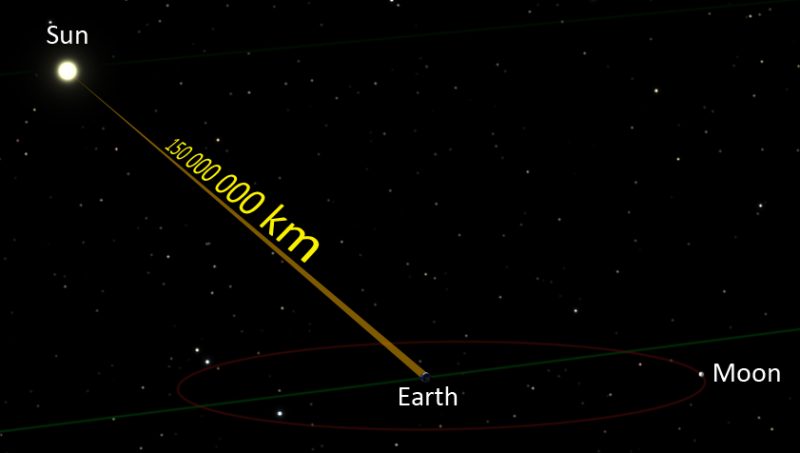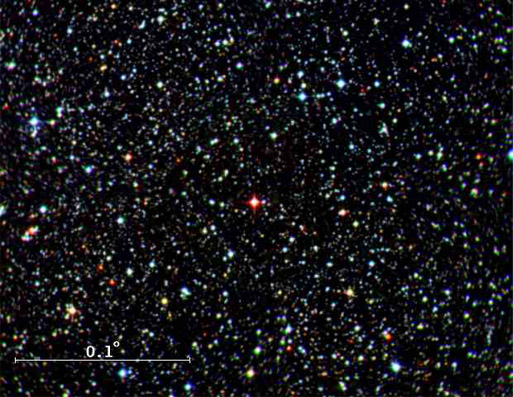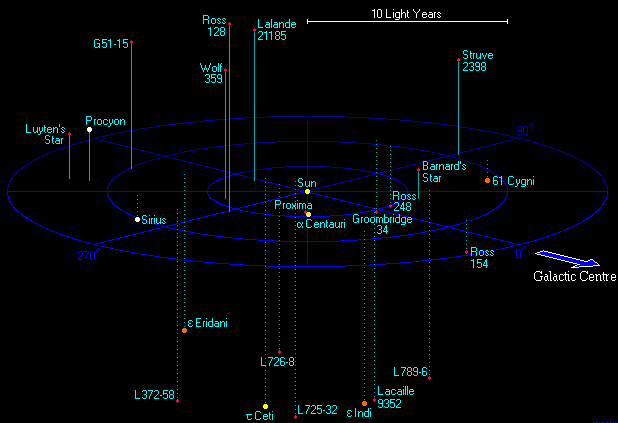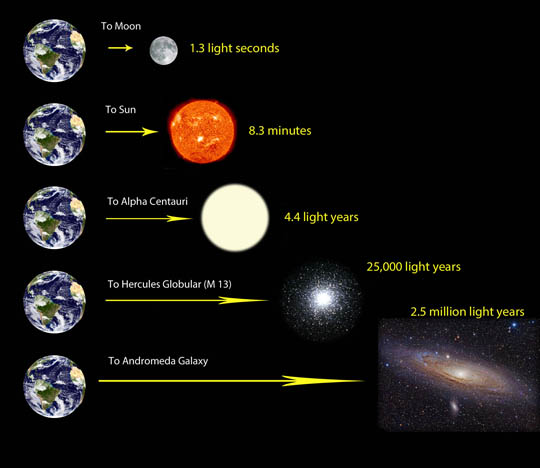How far is a light-year?
How can we comprehend the distances to the stars? This post explains light-years in terms of a scale of miles and kilometers.

The large yellow shell depicts a light-year; the smaller yellow shell depicts a light-month. Read more about this image at Wikimedia Commons.
Stars other than our sun are so far distant that astronomers speak of their distances not in terms of kilometers or miles – but in light-years. Light is the fastest-moving stuff in the universe. If we simply express light-years as miles and kilometers, we end up with impossibly huge numbers. But the 20th century astronomer Robert Burnham Jr. – author of Burnham’s Celestial Handbook – devised an ingenious way to portray the distance of one light-year and ultimately of expressing the distance scale of the universe, in understandable terms.
He did this by relating the light-year to the Astronomical Unit – the Earth-sun distance.
One Astronomical Unit, or AU, equals about 93 million miles (150 million km).
Another way of looking at it: the Astronomical Unit is a bit more than 8 light-minutes in distance.

A light beam takes 8 minutes to travel the 93 million miles (150 million km) from the sun to the Earth. Image via Brews OHare on Wikimedia Commons.
Robert Burnham noticed that, quite by coincidence, the number of astronomical units in one light-year and the number of inches in one mile are virtually the same.
For general reference, there are 63,000 astronomical units in one light-year, and 63,000 inches (160,000 cm) in one mile (1.6 km).
This wonderful coincidence enables us to bring the light-year down to Earth. If we scale the astronomical unit – the Earth-sun distance – at one inch, then the light-year on this scale represents one mile (1.6 km).
The closest star to Earth, other than the sun, is Alpha Centauri at some 4.4 light-years away. Scaling the Earth-sun distance at one inch places this star at 4.4 miles (7 km) distant.

The red star in the center of this picture is Proxima Centauri, our sun's nearest neighbor among the stars. A beam of light from this star takes about 4 years to travel to Earth. Image via hyperphysics.phy-astr.gsu.edu
Scaling the Astronomical Unit at one inch (2.5 cm), here are distances to various bright stars, star clusters and galaxies:
Alpha Centauri: 4 miles (6.4 km)
Sirius: 9 miles (14.5 km)
Vega: 25 miles (40 km)
Fomalhaut: 25 miles (40 km)
Arcturus: 37 miles (60 km)
Antares: 600 miles (966 km)
Pleiades open star cluster: 440 miles (708 km)
Hercules globular star cluster (M13): 24,000 miles (38,600 km)
Center of Milky Way galaxy: 27,000 miles (43,500 km)
Great Andromeda galaxy (M31): 2,300,000 miles (3,700,000 km)
Whirlpool galaxy (M51): 37,000,000 miles (60,000,000 km)
Sombrero galaxy (M104): 65,000,000 miles (105,000,000 km)

There are 33 stars within 12.5 light years of our sun. Image via Atlas of the Universe.
Light is the fastest-moving stuff in the universe. It travels at an incredible 186,000 miles (300,000 km) per second.
That’s very fast. If you could travel at the speed of light, you would be able to circle the Earth’s equator about 7.5 times in just one second!
A light-second is the distance light travels in one second, or 7.5 times the distance around Earth’s equator. A light-year is the distance light travels in one year.
How far is that? Multiply the number of seconds in one year by the number of miles or kilometers that light travels in one second, and there you have it: one light-year. It’s about 5.88 trillion miles (9.5 trillion km).

This scale starts close to home but takes us all the way out to the Andromeda Galaxy, the most distant object most people can see with the unaided eye. Image via Bob King / Skyandtelescope.com.
Bottom line: The scale of light-years expressed as miles and kilometers.
© 2017 EarthSky Communications Inc.
http://earthsky.org/astronomy-essentials/how-far-is-a-light-year